Week 7: Multivariate Evolution + Molecular Evolution
1/46
There's no tags or description
Looks like no tags are added yet.
Name | Mastery | Learn | Test | Matching | Spaced |
|---|
No study sessions yet.
47 Terms
What are univariate characters?
individual characters you can measure
e.g drosophila bristle number or stalk-eyed fly eyespan
Continuous distribution
One dimension
Univariate characters show a straightforward response to artificial selection e.g stalk eyed fly eyespan selected for → wider/ narrow
Responses to selection due to genetic basis of phenotypes
every trait evolves independently
trait specific adaptation/ optimisation
What are multivariate characters?
a trait that has evolved but hasn’t been selected for
e.g male eyespan + female preference in stalk eyed flies
correlated responses
phenotypes are multi-dimensional
Pleiotropy
same genes affect more than one trait
How much can we expect a trait to change over n generations?
Breeder’s equation
R = h²S
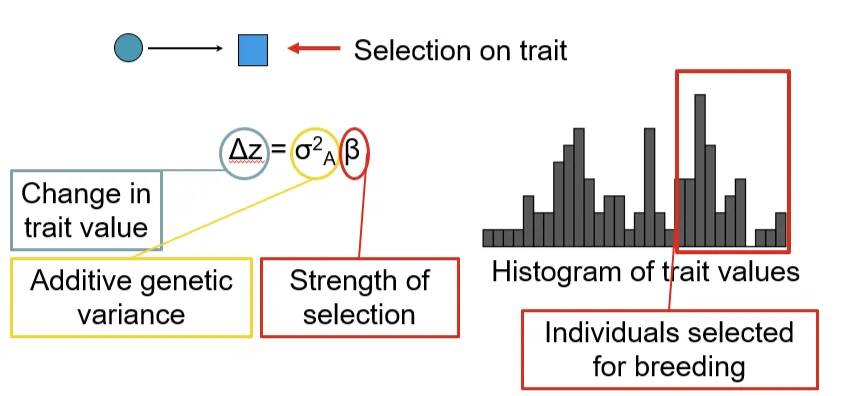
What term is used in the Breeder’s equation to describe genetic variation for a one dimension trait?
additive genetic variance
What is used in the Breeder’s equation to describe genetic variation for 2 dimension traits/ positively correlated values?
Genetic variance-covariance matrix
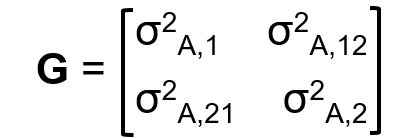
What does it mean if traits do not covary?
Independent evolution – 2 univariate traits
(same as univariate Breeder’s equation)

What happens when traits covary
interference between traits
selection on one trait affects the other trait

Correlated responses
one trait selected, both change
Accelerated responses
positive correlation, selection aligned
Adaptive conflicts
positive correlation, selection opposed
positive selection on trait one, negative selection on trait 2
^ evolutionary stale-mates
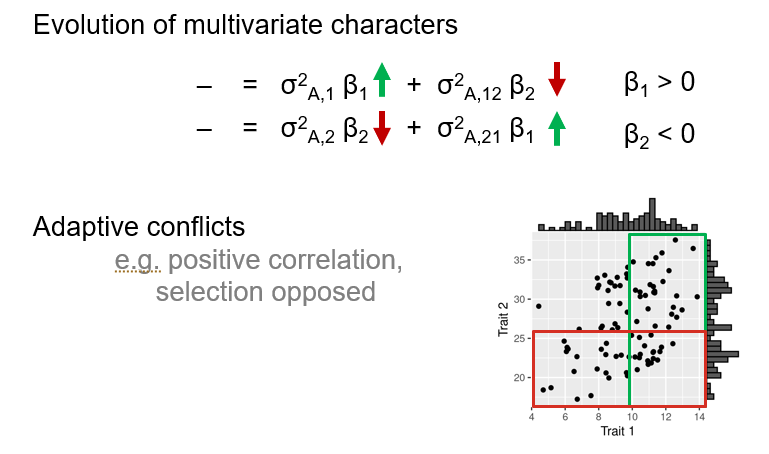
Why does sexual dimorphism happen?
different reproductive roles
opposing selection pressures on a shared trait → because of differing reproductive roles→ drives sexual dimorphism
What are males reproductive roles limited by?
limited by mating partners
cheaper gametes
What are female reproductive roles limited by?
expensive gametes
limited by resources gathered
Example of opposing selection pressures on the same trait
Locomotion in D. melanogaster , Long and Rice (2007)
genotypes with high fitness move little
low fitness move a lot
female fruit-fly → don’t waste time moving
in males → positive selection for more movement → increase fitness, encounter mates
How does sexual dimorphism occur when genomes are shared between sexes?
only part of DNA restricted is chromosome 23 or sex chromosomes - Y chromosome → in males any beneficial mutation may be fixed on Y chromosome
on other genes → adaptive evolution happens less
Inter-sexual genetic correlations are high
multivariate characters
What are the two phases for the evolution of sexual dimorphism
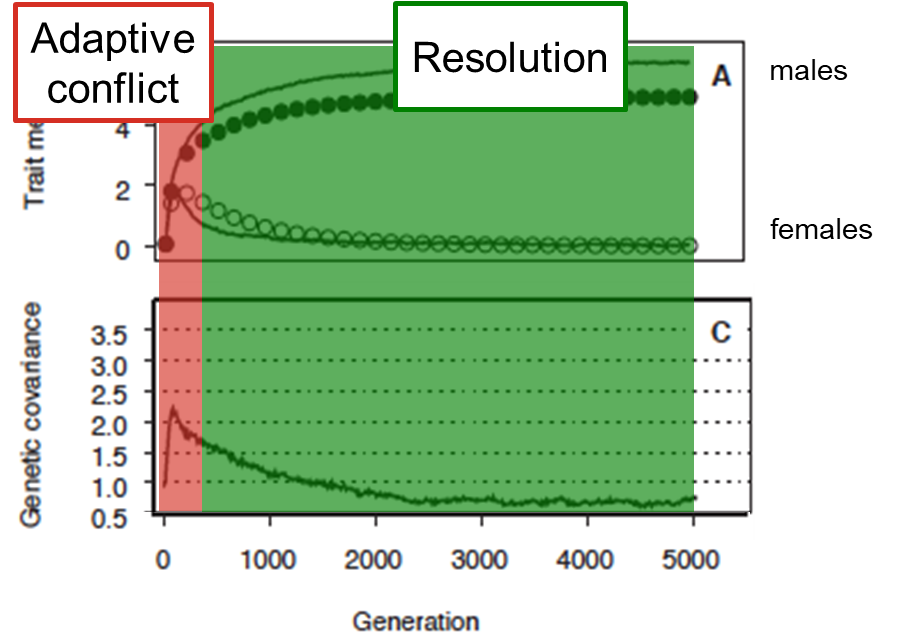
Sexual antagonism
Adaptive conflict between the sexes
New mutations are
beneficial to one sex
deleterious to the other sex
Mutations can invade if the benefits to one sex outweigh the costs in the other sex
Evidence for sexual antagonism
Chippindale et al. (2001)
D. melanogaster
Negative correlation between male and female fitness
GWAS used (Ruzicka et al. 2019) → 2,372 SNPs, ~200 clusters in genome involved in adaptive conflict
Conflict resolution→ has happened since males and females are different
via mutations that break down genetic correlation
Mutations in regulatory regions → sex-specific gene expression
Mutations in genic regions → sex-specific protein variants
Example of conflict resolution
Bonduriansky and Rowe (2005)
In waltzing flies
What is molecular evolution?
Change measured at the scale of DNA, RNA or proteins.
Hereditary variation is the medium of evolution – the result of underlying changes at the DNA level
Track evolutionary change by examining sequence changes over time
What causes molecular evolution?
mutations
non-synonymous substitution → alters AA + potential to affect gene function
The amino acid change may affect aspects of resultant protein molecule
folding structure, binding properties, hydrophilic/hydrophobic
How are deleterious mutations removed?
by purifying selection
How are advantageous mutations fixed?
by positive selection
Example of fixation via intense positive selection
Tibetan plateau, extreme altitude, O2 pressure < 2/3 of sea level value
Plot of SNP polymorphisms for Tibetans versus Han Chinese (~sea level). Strong correlation, alleles common or rare in both populations.
Exceptions in EPAS1 gene: 90% in T, 10% in HC
EPAS1 gene has an allele that confers advantages at high altitudes by increasing production of red blood cells– has been selected in Tibetan population.
Downside is that more red blood cells increases blood viscosity and risk of heart attack
Mutations that have no effect on gene function
silent/ synonymous substitutions
Molecular clock explained by neutral theory
For genes accumulating differences by drift, number of differences between 2 species is proportional to the time since their most common ancestor → a linear relation between time and divergence
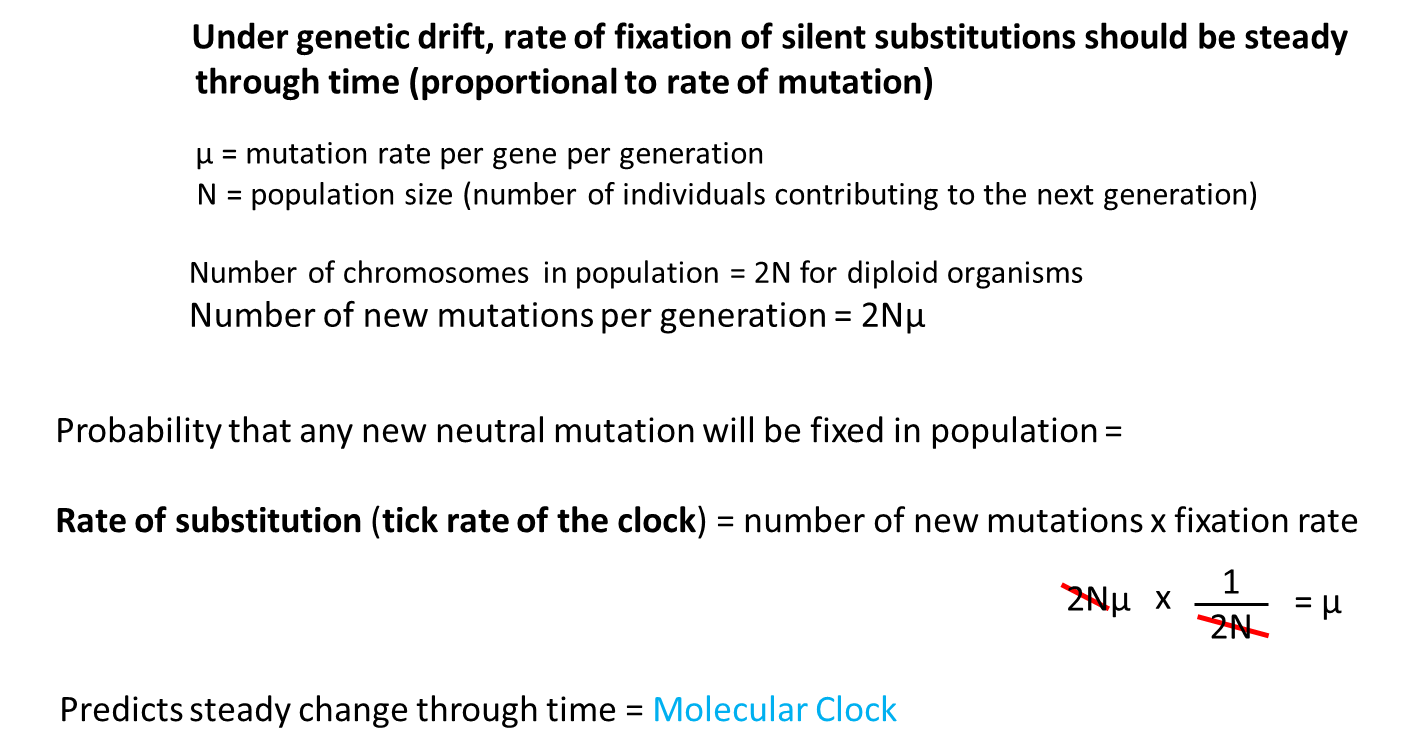
Most common substitutions
Rate of silent substitutions is higher than rate of non-synonymous substitutions.
Among non-synonymous substitutions, changes to amino acids with similar biochemical properties (e.g. both hydrophilic) are more common than changes with greater effect on protein function.
What kind of sequences are free from purifying selection?
non-coding sequences e,g introsn + pseudogenes
evolve at a higher rate similar to silent sites
What kind of genes evolve more slowly?
genes with higher functional constraints
fewer mutations in these genes are neutral
e.g histones are critical in fundamental processes of chromosome assembly and replication hence histone sequence and structure are slowly evolving.
Uses for the molecular clock
Phylogenetic relationships
Speciation rates
Divergence Times
Is the molecular clock reliable?
Mutation rate is assumed to be constant
Population size (Ne) assumed to be of similar magnitude at occurrence of mutation and in subsequent period of potential fixation
if population suffers drastic bottleneck after mutation’s occurrence, fixation more likely and clock speeds up
Selection is assumed to be constant
adaptive bursts do happen e.g adaptation to a new food source
What is mutation rate affected by?
higher metabolic rate - causes more oxidative damage to DNA = faster tick rate
generation time - faster generation time increases number of meiotic divisions per year = faster tick rate
Example: Mammal phylogeny
Rodents : high metabolic rate + short generation time → elevated mutation rate
Example of adaptive burst
Rhagoletis fly
Adaptive shift in food source from hawthorn to apple
Changed selective regime for genes involved in host plant choice and food metabolism pathways
Studies showing the constancy of molecular evolution
The Hawaiian Molecular Clock
Volcanic origins have produced chain of islands of increasing geological age. Molecular data confirm order of colonisation
Example: Honeycreeper species’ phylogeny: species of oldest islands form deepest branch of tree, those of younger islands tree’s tips.
Disparate taxa (birds/insects) show linear relationship between genetic divergence and time when DNA distance between sister species plotted against geological estimates of island age (young to old on X-axis).
dN / ds
relative rate of functional evolution
dN = coding/ replacement/ non synonymous sites
ds = silent (synonymous) sites
Life-cycle of a substitution
Born as a mutation in one individual - it is a low frequency polymorphism
Fate
If deleterious, tend to decrease in frequency and disappear
If advantageous, tend to increase in frequency.
Persists as polymorphism until displaces all alternative alleles in population.
Mutation → polymorphism → becomes a substitution when all alternative versions have disappeared
When all of population carry copy of same mutation - it is fixed in population
dN / ds = 1
Synonymous and non-synonymous mutations have little effect on fitness and evolve largely neutrally
Both have similar chance of drifting through population to fixation
Sites accumulate differences between species by random genetic drift
dN / ds > 1
Many non-synonymous replacements advantageous, fixation via boost from positive selection
Under positive selection, non-synonymous sites will evolve more quickly than neutral synonymous sites and differences between species can build up rapidly
replacements are advantageous, fixed by positive selection
dN / ds < 1
most synonymous replacement are deleterious and removed by purifying selection
replacement are deleterious, removed by purifying selection
Example of Molecular signatures of Adaptive Change: HIV surface envelope protein
Branch-specific dN/dS is elevated in those lineages with recent HIV transmission and high pathogenicity
Suggests positive selection operating on envelope protein following recent shifts to new hosts.
Note that surface protein’s function is to foster viral entry into host cells
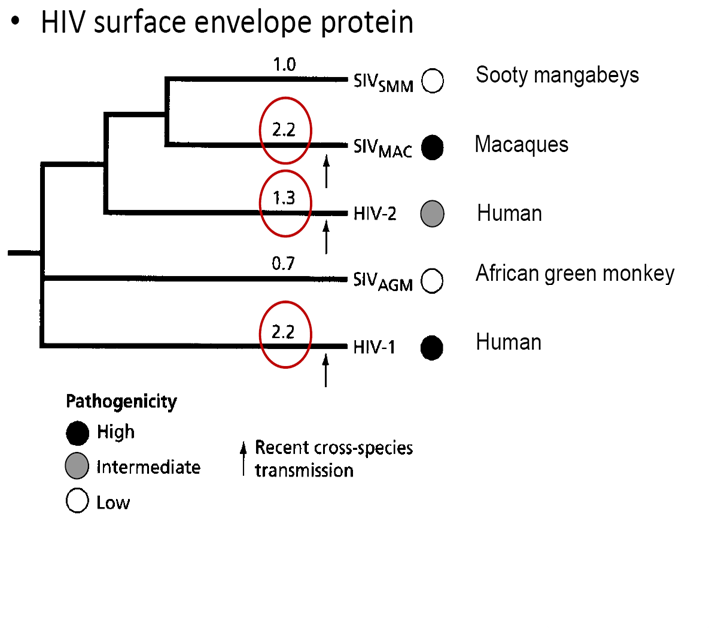
Example of Molecular Signatures of Adaptive Change: BRCA1 human gene
Ratio is high on branches of primate phylogeny leading to chimps and humans. - What caused the positive selection? Unclear.
BRCA1 is responsible for cases of breast cancer.
The BRCA1 protein plays role in repair of damaged DNA, hence why mutations in gene cause cancer. Some claims that BRCA1 part of host defense against viral DNA/proteins
Perhaps coevolution with viruses drove rapid evolution but side-effect that more likely to mutate to cancer-triggering form.
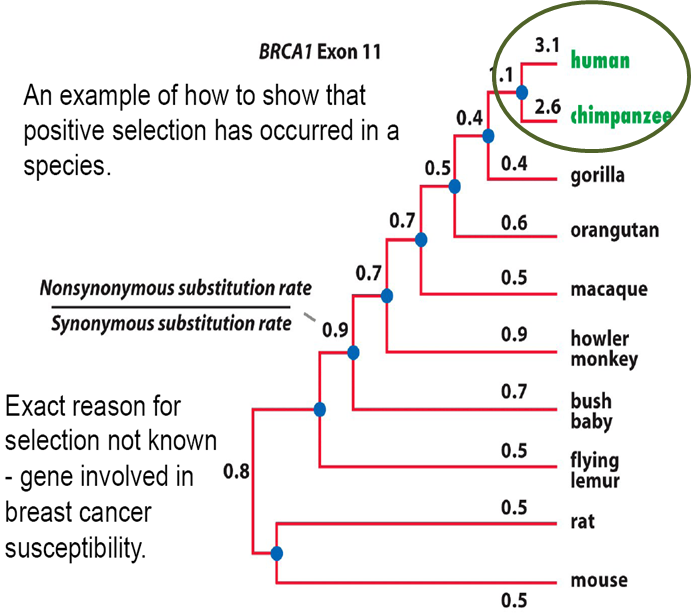
Fraction→ dN / ds
McDonald-Kreitman Test
M-T test + related tests assay positive selection by extending dN / dS ratio test on differences in substitutions between species, to include data on polymorphism within a focal species
M-K test compares
ratio of non-synonymous to synonymous polymorphisms within species
to
ratio of non-synonymous to synonymous substitutions between species
How does gene duplication arise?
mispairing during recombination
Pseudogene
Often build up of mis-sense and regulatory mutations→ leads to gene death
Subfunctionalisation
sometimes copy takes over one aspect of original gene function - both copies are required to carry out the job of the original gene
Neofunctionalisation
the gene copy can take on a new role entirely